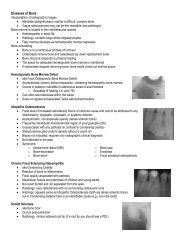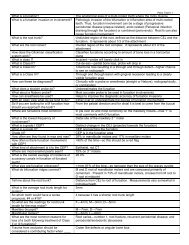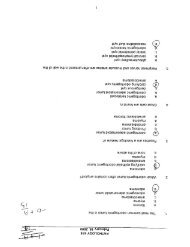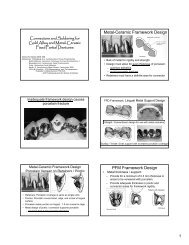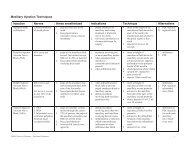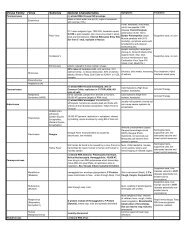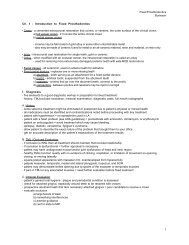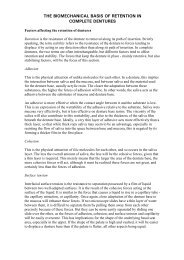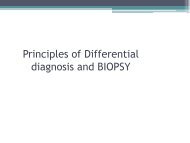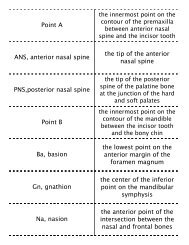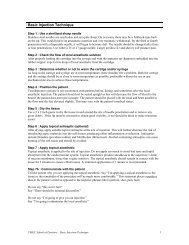FACIAL NEUROPATHOLOGY
FACIAL NEUROPATHOLOGY
FACIAL NEUROPATHOLOGY
You also want an ePaper? Increase the reach of your titles
YUMPU automatically turns print PDFs into web optimized ePapers that Google loves.
<strong>FACIAL</strong><br />
<strong>NEUROPATHOLOGY</strong><br />
ORO<strong>FACIAL</strong> PAIN
NOCICEPTORS:1-5MM DIAMETER NERVE<br />
FIBERS.
PAIN FIBERS(PERIPHERAL<br />
NERVE FIBERS)<br />
! A-DELTA:<br />
! Responsible for<br />
temperature and<br />
fast or first pain.<br />
! Faster<br />
! Conduction velocity<br />
is 12-45 m/sec<br />
! Myelinated<br />
! C-FIBERS:<br />
! Responsible for<br />
slow or second<br />
pain, and<br />
temperature.<br />
! Is unmyelinated<br />
! Much slower<br />
! Conduction velocity<br />
is 0.2-2.0 m/sec<br />
! Odontogenic pain<br />
from pulp is<br />
associated with this
TYPES OF CUTANEOUS PAIN<br />
! 1. Pricking pain, which is felt rapidly.<br />
It is felt that pricking pain is mediated<br />
by A-delta fibers. A fibers also<br />
conduct touch, warmth, and cold<br />
! When you first feel the stick from a<br />
needle<br />
! 2. Dull, aching sometimes burning<br />
pain, which is mediated by C fibers. C<br />
fibers also conduct itch, warmth, and<br />
cold
THE TRIGEMINAL SYSTEM<br />
! All sensory input from the face and<br />
mouth is carried by V (trigeminal).<br />
! Cell bodies of the trigeminal afferent<br />
neurons are located in the gasserian<br />
ganglion<br />
! Impulses carried by V enter directly<br />
into brainstem(pons) and synapse in<br />
the trigeminal spinal tract nucleus<br />
! Spinal tract nucleus responsible in most<br />
cases in significant pain
SPINAL TRACT NUCLEUS<br />
! Divided into 3 parts:<br />
A. the subnucleus oralis<br />
Significant for association with oral<br />
pain mechanisms<br />
B. the subnucleus interpolaris<br />
C. the subnucleus caudalispredominates<br />
in trigeminal<br />
nociception
PRIMARY<br />
NEUROTRANSMITTERS<br />
FOR PAIN TRANSMISSION<br />
Glutamate - an amino acid<br />
Substance P – a peptide
TISSUE INJURY:causes K+,<br />
bradykinin and arachidonic acid<br />
release
Release of Substance P cause<br />
release of histamine and<br />
serotonin(5HT), and more<br />
bradykinin
Release of substance P, histamine,<br />
serotonin initiate more nociception
PAIN EXPERIENCE<br />
! Involves the psychologic (past<br />
experiences, cultural behaviors and<br />
emotional state) and<br />
! Physiologic aspects(involves the<br />
transduction,transmission and<br />
modulation of pain)<br />
! The experience of pain is linked to<br />
emotional,behavioral, and cognitive<br />
phenomena
EVALUATION OF<br />
MAXILLO<strong>FACIAL</strong> PAIN<br />
SENSORY DYSFUNCTION<br />
! Obtain a chief complaint and include onset,<br />
clinical course since onset, intensity and<br />
location<br />
! Ask for assessment by the pt for objective/<br />
subjective descriptors i.e. is dysfunction<br />
intermittent/continuous; character of pain<br />
(throbbing, deep, area/face feel wooden);<br />
does it occur in relation to other functions<br />
(with function or spontaneous); precipitants<br />
or reliever of sxs; associated sxs etc
DESCRIPTORS OF ALTERED<br />
SENSATION<br />
! Numb<br />
! Tingling<br />
! Wet<br />
! Rubbery<br />
! Stretched<br />
! Swollen<br />
! Crawling<br />
! Itching<br />
! Prickling<br />
! Electric<br />
! You have blood<br />
flow but you have<br />
transmission that is<br />
affected<br />
! Tender<br />
! Painful<br />
! Burning<br />
! Very problematic
EVALUATE CRANIAL NERVES
INSPECTION / EXAMINATION<br />
! Skin changes in color or texture<br />
! More pitted and more pallor<br />
! Atrophic changes<br />
! Iatrogenic induced trauma<br />
! If the patient is numb the will probably<br />
have areas where they have bit their<br />
tongue<br />
! Decreased/altered taste (affected<br />
lingual nerve), difficulty in chewing<br />
! Difficulty in speaking or facial
AXIS I (PHYSICAL CONDITIONS)<br />
! Cutaneous and mucogingival pains<br />
! Mucosal pains of the pharynx, nose,<br />
and paranasal sinuses<br />
! Pains of the musculoskel. Structures<br />
of the mouth/face<br />
! Pains of the visceral structures of<br />
mouth/face<br />
! Pains of the neural structures of<br />
mouth/face
AXIS II (PSYCHOLOGIC<br />
CONDITIONS)<br />
! Anxiety disorders<br />
! Mood disorders<br />
! Somatoform disorders<br />
! Other conditions, such as<br />
psychologic factors affecting a<br />
medical condition<br />
PSYCHOLOGIC INTENSIFICATION<br />
OF PAIN
<strong>FACIAL</strong> NEURALGIAS<br />
! Trigeminal Neuralgia<br />
! Glossopharyngeal Neuralgia<br />
! Geniculate Neuralgia<br />
! Superior Laryngeal Neuralgia<br />
! Occipital Neuralgia
NEURALGIA:<br />
Defined as paroxysmal,<br />
intermittent pain confined to<br />
specific nerve branches
TRIGEMINAL NEURALGIA<br />
! Characterized by<br />
severe recurrent<br />
episodic attacks of<br />
unilateral pain<br />
distributed over a<br />
branch or, after<br />
many years, more<br />
than one branch of<br />
V. Associated with<br />
trigger zones<br />
! Incidence per<br />
100,000: 2.7 men<br />
and 5.0 for women<br />
! Pain usu. in V-2 or<br />
V-3 in 60% of pts.<br />
! More often on Rt<br />
side of body<br />
! 70% of pts over the<br />
age of 50
TRIGEMINAL NEURALGIA<br />
! KEY: No sensory/<br />
motor loss<br />
! Everything is intact<br />
! Compression or<br />
distortion of the nerve<br />
root by an aberrant<br />
arterial loop<br />
! 2-4% of cases of TN<br />
have MS<br />
! TX: 1.Anti-Epileptic<br />
Drugs:<br />
Gabapentin,baclofen,lamotrigine,carba<br />
mazepine,oxcarbamaz<br />
epine<br />
2.SURG:Radiofrequen<br />
cy thermolysis,<br />
Microvascular nerve<br />
root decompression<br />
(requires opening up<br />
of the skull),Gam- ma<br />
knife radiation
VASOGLOSSOPHARYNGEAL<br />
NEURALGIA<br />
! Rarer than trigeminal neuralgia<br />
! Charac. by unilateral paroxysmal stabbing<br />
pain in the posterior 1/3 of the tongue,<br />
pharynx,larynx, and soft palate. Cranial nn<br />
IX & X involved<br />
! Pain assd. with trigger zone, talking and<br />
swallowing usual stimulus<br />
! Bradycardia, hypoten., and syncope seen<br />
from activation of X<br />
! Tx: tegretol or phenytoin, topical<br />
anesthesia of pharyngeal mucosa
POST-ZOSTER NEURALGIA<br />
RAMSAY HUNT SYNDROME<br />
! Herpes zoster is a self-limiting dz<br />
! M=F in frequency; 65% over age 70n<br />
! Syndrome arises from geniculate<br />
gangliositis. This results in a)facial<br />
paralysis, b)loss of taste of anterior<br />
2/3 of tongue , c)loss of lacrimation,<br />
d)vesicular eruption of the external<br />
ear and e)severe pain in EAC
RAMSAY HUNT CON,T<br />
! Pain in the ear is severe and<br />
paroxysmal<br />
! Pain persists for weeks to years after<br />
eruption disappears<br />
! Herpes zoster (shingles) is the<br />
consequence of reactivation of the<br />
latent varicella-zoster(also causes<br />
chickenpox) virus.
POSTHERPETIC NEURALGIA-<br />
TRIGEMINAL GANGLIA<br />
! Similar syndrome as Ramsay Hunt<br />
except inflammation of the trigeminal<br />
ganglion by herpes zoster.<br />
! The dermatomal distribution is now<br />
associated with V-1, V-2, or V-3, and<br />
is associated with viral reactivation<br />
! 10-15% of cases, reactivation is in the<br />
ophthalmic division (ophthalmic<br />
zoster)
POST HERPETIC NEURALGIA<br />
! TX:Acyclovir, famciclovir, or<br />
valaciclovir. Result in more rapid<br />
resolution of cutaneous lesions and<br />
decreased viral shedding. Famciclovir<br />
associated with accelerated<br />
resolution of postherpetic neuralgia
SUPERIOR LARYNGEAL<br />
NEURALGIA<br />
! The superior laryngeal nerve is a br.<br />
of the Vagus, innervates the<br />
cricothyroid muscle. Will see periodic,<br />
unilateral submandibular pain<br />
radiating through eye, ear, and<br />
shoulder. Similar to IX neuralgia<br />
! Provoked by swallow/turn of the<br />
head/sneezing/yawning/nose blowing
OCCIPITAL NEURALGIA<br />
! The greater occipital nerve is a<br />
continuation of the C2 nerve and<br />
innervates the posterior scalp.<br />
! Will feel paroxysmal pain in posterior<br />
occipital region and cervical region
ATYPICAL <strong>FACIAL</strong> PAIN<br />
! Usually is a dx. of exclusion<br />
! Pain does not follow anatomic distribution<br />
of the Trigeminal nerve, crosses the<br />
midline and not limited to sensory<br />
distribution of a single nerve<br />
! More common than trigeminal neuralgia<br />
! 4 th -5 th decade; F>M; classified as<br />
a)psychogenic b)organic c)indeterminate
HEADACHES<br />
! Types: 1) Tension a)episodic or<br />
b)chronic. The chronic type may<br />
have a duration of 5 years or longer in<br />
75% of pts. Tx with<br />
antidepressants(tricyclic)or NSAIADs<br />
2)Vascular a)Migraines:paroxysmal<br />
headache lasting 24-72 hrs, usually<br />
unilateral. Frequency variable and<br />
aura or prodrome may precede
HEADACHES CON’T<br />
! 2-a) Migraines con’t: 80% of pts with family<br />
history. In childhood M>F, but after<br />
menarche F>M. Tx with compression of<br />
temporal artery, cold compress,<br />
biofeedback,narcotics. 2-b: Cluster also<br />
called Horton’s headache. 8X more<br />
common in men. May see family<br />
aggregation. Last from 15 min to 2 hrs but<br />
may occur 5-10x a day, periorbital in<br />
location and unilateral. Tx:Lithium, O2,<br />
intranasal lidocaine spray
HEADACHE CON’T<br />
! 3)Temporal arteritis, is an<br />
inflammation of medium- and largesized<br />
arteries. Usually involves a<br />
branch of the carotid artery, but is a<br />
systemic dz, and may involve arteries<br />
in multiple locations. Occurs over the<br />
age of 55, F>M, and associated with<br />
polymyalgia rheumatica. Complex of<br />
fever,anemia, high ESR and HA. Tx<br />
with steroids.
TRAUMATIC NERVE INJURIES
NERVE INJURIES-CAUSATION<br />
! Inferior alveolar: Fractures of<br />
mandible, BSSO, 3 rd molar removal,<br />
resection of mand.,preprosthetic<br />
surgery, implant- nerve repositioning<br />
procedures<br />
! Lingual: 3 rd molar removal, resection,<br />
salivary gl. Removal, fracture and<br />
repair of mand. Angle fxs
NERVE INJURY CLASSIFICATION<br />
! Seddon: neuropraxia, axonotmesis,<br />
and neurotmesis<br />
! Sunderland: 1st through 5 th degree
PATIENT EXAMINATION
PATIENT EXAM CON’T
PATIENT EXAM CON’T
MAPPING
PIN PRESSURE NOCICEPTION
THERMAL DISCRIMINATION
ALL PATIENTS<br />
! Brush stroke directional-tests<br />
proprioception<br />
! 2 point discrimination<br />
! Sharp vs blunt<br />
! Subjective assessment, objective<br />
analysis
NERVE INJURY TREATMENT<br />
! Time of injury vs sensations felt<br />
! Surgery: Internal neurolysis<br />
Excision of neuroma<br />
Free nerve graft-The Sural nerve for<br />
infer. alveolar,lingual,infraorb.<br />
Another grafting donor site is the<br />
Greater auricular nerve<br />
Conduits
LINGUAL NERVE NEUROMA
COLLAGEN CONDUIT



